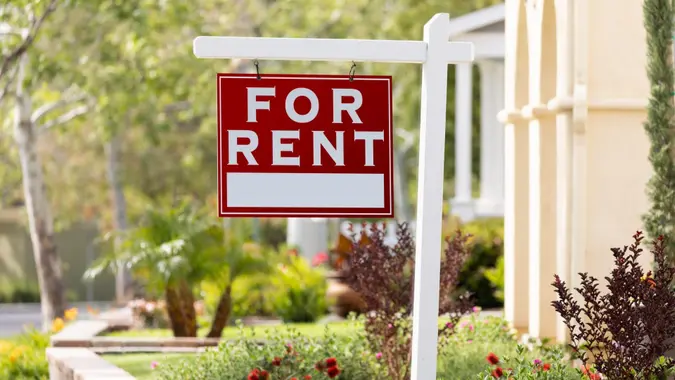7 Key Signs That House Is a Money Pit

Commitment to Our Readers
GOBankingRates' editorial team is committed to bringing you unbiased reviews and information. We use data-driven methodologies to evaluate financial products and services - our reviews and ratings are not influenced by advertisers. You can read more about our editorial guidelines and our products and services review methodology.

20 Years
Helping You Live Richer

Reviewed
by Experts

Trusted by
Millions of Readers
Buying a house can be a very rewarding experience. So, when you’ve finally found one that you can envision being your dream home, you might be tempted to put in an offer right away. Before you do, however, it’s important to consider the true cost of purchasing that home.
For most prospective buyers, getting a thorough home inspection is a great way to uncover any hidden issues that’ll need to be addressed before or after you buy. If you want to be prepared before getting to that stage in the buying process, there are several common signs that the property you’ve got your eye on is a money pit that’s going to cost you more money than it’s worth.
Visible Foundation or Structural Issues
The foundation, along with other features like load-bearing walls, makes up the overall structural integrity of your seemingly perfect home. If it’s showing visible signs of damage, chances are it’s going to cost you a lot to repair it. These signs can include foundation cracks, sagging floors or leaning walls.
Any real estate agent should warn you of foundation problems, and they should be sought out by home inspectors. These issues can be extremely costly and challenging to rectify after the dust settles on the closing costs of buying a home. It’s estimated that foundation repair can be among the largest expenses that can sink a home purchase, ranging from a few thousand dollars to upwards of $40,000.
Harmful Chemicals on the Property
It’s to be expected that older houses will require a bit more home maintenance and elbow grease to get them up to snuff. However, depending on their age, these properties could contain harmful chemicals or other hazardous materials in their construction, such as lead paint or asbestos.
You can usually find these harmful materials if the house has its original shingles and siding, as that will often contain asbestos. A professional inspector will be able to identify this before disturbing it. Don’t take asbestos lightly, as it can be deadly. Just know that removing it can cost between $50 and $150 per square foot.
Lead-based paint is another big issue to consider, as it can lead to expensive abatement procedures to ensure a safe living environment. Lead paint removal runs around $8 to $15 per square foot, so size (again) drives the total cost, and can really add up.
Aging Roof or Windows
Another sign that you’re in for some expensive repairs with your home purchase is that the roof or windows are old and need to be replaced. This comes with a big price tag as replacing a roof, windows or siding will cost $10,000 or more, sometimes even surpassing $50,000. You can’t really put these repairs off either, as these items serve as your protection from the outside, and they need to be taken care of quickly so as not to risk additional damage.
That being said, needing to replace all of these systems will drive your home costs into the six-figure range. If you ignore these, your money pit will only grow deeper. If left in deteriorating conditions, the roof or windows can cause more significant problems, such as rot, mold, mildew and even structural issues.
Plumbing Issues and Water Damage
Signs of water damage often indicate that you’re going to need to pour money into your new home to fix those issues. If you don’t have a rainy-day emergency fund, you could be up a creek financially with this home repair expense.
If you see signs of water damage, dampness or the presence of mold, it suggests underlying issues that may require professional remediation, often accompanied by a high price tag. For example, these repairs can run $2,000 to $9,000 when handled by a licensed professional.
As for plumbing issues, outdated or corroded plumbing systems, especially in older homes, may necessitate a complete overhaul to prevent leaks, water damage and potential health hazards. Partial replacement of some pipes can run $2,000, with a complete re-piping of a house running closer to $14,000. Keep in mind that costs vary based on other factors as well, such as accessibility to the pipes.
Poor Insulation
If the home has inadequate insulation or poor energy efficiency, it could also be a money pit. This can be bad for both the environment and your monthly budget, as homes lacking proper insulation or energy-efficient appliances and features could wind up with high utility bills.
That being said, adding insulation can run $1,000 to $4,000, while window replacement will almost always lead to around $1,500 per window in costs. Your inspector can physically measure the amount of insulation, and more thorough inspectors can measure the temperature leakage at windows.
Signs of Infestation
The last thing you want is for your new home to be eaten away before your very eyes. Signs of a termite infestation — like sunken areas in the walls or discarded shells or wings — could also be expensive to fix.
Though termite damage or active infestations can lead to extensive repairs, you can’t really afford to put it off, as addressing the issue promptly is the only way to prevent further structural deterioration. In many cases, isolated repairs can run between $2,000 and $15,000, with total infestations possibly leaving the building incapable of being repaired. Yikes.
Outdated Electrical System
Another common issue found in older homes is an outdated electrical system. Unfortunately, this can also be a costly fix. Make sure to heed the warning signs if the house you’re hoping to buy has an outdated or inadequate electrical system. This could require extensive rewiring to meet modern safety standards, which could cost you anywhere between $8,000 to $20,000.
The good news is that most outdated electrical systems are fairly obvious for any level of home inspector to diagnose, with knob-and-tube and cloth-covered wires being an immediate alert that repairs are needed. Make sure they take this important step.
Angela Mae contributed to the reporting of this article.
 Written by
Written by  Edited by
Edited by 


























